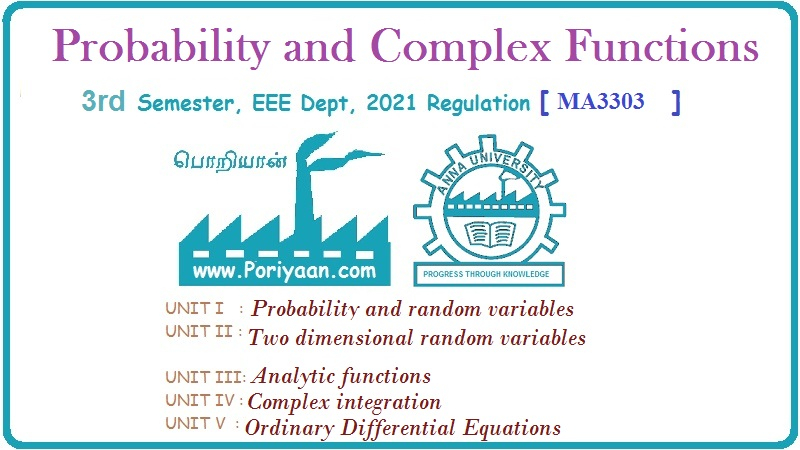Probability and complex function: Unit V: Ordinary Differential Equations
Problems based on method of variation of parameters
Solved Example Problems | Ordinary Differential Equations
Probability and complex function: Unit V: Differential equations : Problems based on method of variation of parameters
II. Problems
based on method of variation of parameters
Example 5.2.1. Solve (D2
+ a2) y= tan ax by the method
of variation of parameters. [A.U. M/J
2005, A/M 2008, N/D 2007] [A.U M/J 2009, M/J 2013] [A.U N/D 2014] [A.U N/D 2016 R-15, A/M 2017
R-8] [A.U A/M 2019 R-17]
Solution:
Given: (D2 + a2) y = tan ax
The
auxiliary equation is m2 + a2 = 0
m
= ±ai
C.F
= e0x [C1 cos ax + C2 sin ax]
C.F
= C1 cos ax + C2 sin ax

=
a cos2 ax + a sin2 ax
=
a[cos2 ax + sin2 ax]
P.I
= P f1 + Q
f2

=
-1/a2 [ cos ax lg ( sec ax + tan ax) ]
Y
= C.F + P.I
y
= C1 cos ax + C2 sin ax – 1/a2 cos ax log [sec
ax + tan ax]
Example 5.2.2 Solve (D2+
a2) y = a2 tan ax by the method of variation of paramters.
Solution : Hint:
In the Example 5.2.1
X
= a2 tan ax, we get
P
= sin ax - log (sec ax + tan ax), Q = - cos ax
P.I
= Pf1 + Qf2
Y
= C.F + P.I
y
= C1 cos ax + C2 sin ax - cos ax log [sec ax + tan ax]
Example 5.2.3. Solve d2y
/dx2 + 4y = 4 tan 2x using method of variation of parameters. [A.U N/D 2014 R-13, D2015/Jan.2016]
Solution:
Hint: In the Example 5.2.2 put a = 2, we get
y
= (C1 cos 2x + C2 sin 2x) - cos 2x log (sec 2x + tan 2x)
Example 5.2.4. Solve: d2y/dx2
+ y = tan x by the method of variation of parameters.[A.U N/D 2003] [A.U
M/J 2016 R-13]
Solution:
Hint: In the Example 5.2.1 put a = 1, we get
y
= C1 cosx + C2
sinx – cos x log (sec x + tanx)
Example 5.2.5. Solve (D2+
a2) y = sec ax using the method of variation of parameters. [A.U.
M/J 2012]
Solution:
Given: (D2 + a2) y = sec ax
The
auxiliary equation is m2 + a2 = 0
m2
= -a2
m
= ± ai
C.F
= C1 cos ax + C2 sin ax
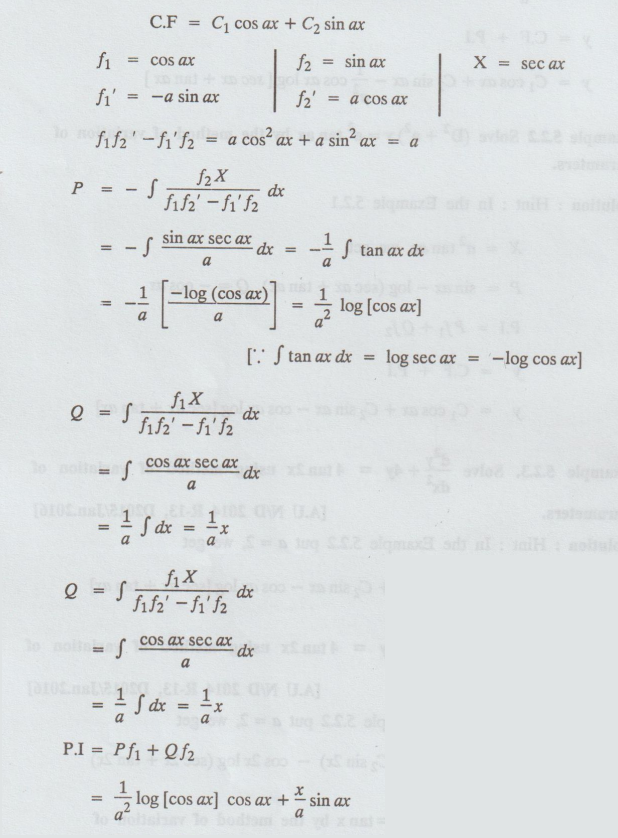
P.I=
Pf1 + Qf2
=
1/a2log [cos ax] cos ax + x/a sin ax
Example 5.2.6. Use the method of variation
of parameters to solve (D2 + 1) y = sec x. [AU, Dec. 1999, A.U. A/M
2004, A.U(Trichy) J/J 2008] [A.U D15/J16 R-13] [A.U N/D 2016 R-13]
Solution:
Hint: In the Example 5.2.5 put a = 1, we get
y
= C1 cosx + C2 sinx + cos x log (cosx) + x sinx.
Example 5.2.7. Solve (D2
+ 4) y = sec 2 x by the method of variation of parameters. [AU, March 1996, AU
Model, A.U. N/D 2002, CEG Nov. 2002] [A.U N/D 2010 R-8]
Solution: Hint:
In the Example 5.2.5 put a = 2, we get
y
= C1 cos 2x + C2 sin 2x + ¼ log [ cos 2x cos 2x + ½ x sin
2x
Example 5.2.8. Solve d2y/dx2
+ y = cosec x by using method of variation of parameters. [A.U N/D 2012] [A.U
A/M 2011 R-8] [A.U. N/D 2019, R-17]
Solution:
Given: d2y/dx2
+ y = cosec x
i.e.,
(D2 + 1) y = cosec x
The
auxiliary equation is m2 + 1 = 0
m
= ± i
C.F.
= C1 cos x + C2 sin x
Here,
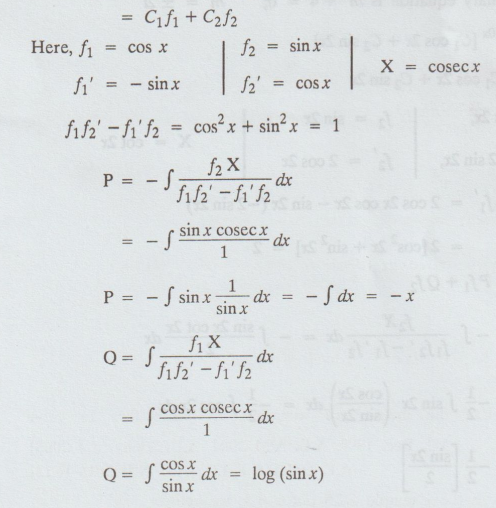
P.I
= P f1 + Q f2
=
-x cos x + log (sin x) sin x
y=
C.F + P.I
C1 cos x + C2 sin x = -
x cos x + sin x log (sin x)
Example 5.2.9 Solve (D2+
a2) y = cosec ax by the method of variation of parameters.
Solution: Hint:
f1f2' -f1'f2 = a
P
= -x/a Q = 1/a2 log ( sin ax)
y
= C1 cos ax + C2 sin ax – x/a cos ax + 1/a2 sin
ax log (sin ax)
Example 5.2.10. Apply the method of
variation of parameters to solve (D2 + 4) y = cot 2 x [A.U N/D 2009, N/D 2011]
[A.U N/D 2015 R-13]
Solution:
Given: (D2 + 4) y = cot 2x
The
auxiliary equation is m2 + 4 = 0 ; m = ± 2i
C.F
= e0x [C1 cos 2x + C2 sin 2x]
C.F
= C1 cos 2x + C2 sin 2x
Here
,
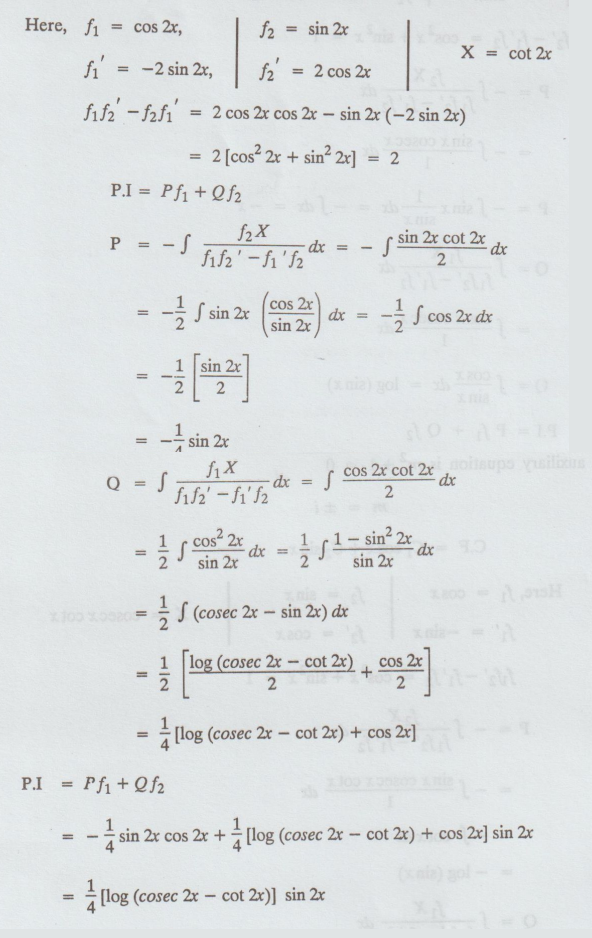
y
= C.F + P.I.
=
C1 cos 2x + C2 sin 2x + ¼ [log (cosec 2x - cot 2x)] sin 2x
5.2.11 Solve (D2 + a2)
y = cot ax by the method of variation of parameters.
Solution:
Hint: f1f2' -f1' f2 = a

Example 5.2.12. Solve d2y/dx2 + y =
cosec x cot x using the methd of variation of parameters. [A.U. N/D 2007] [A.U
A/M 2015 R8]
Solution: Given:
d2y/dx2 + y = cosec x cot x
i.e.,
(D2 + 1) y = cosec x cotx
The
auxiliary equation is m2 + 1 = 0
m
= ±i
C.
F = C1 cos x + C2 sin x
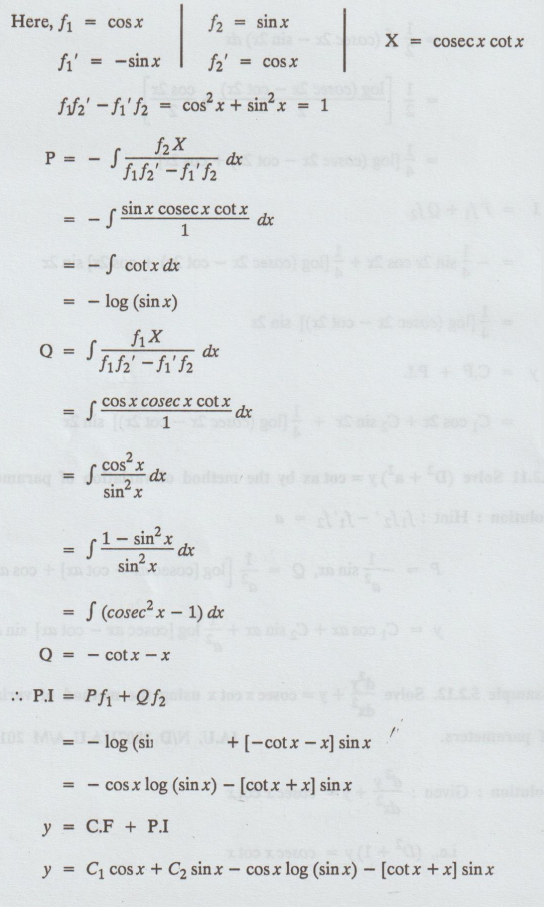
y
= C1 cosx + C2 sinx – cosx log (sin x) – [cotx +x]sin x
Example 5.2.13. Solve by the method
of variation of parameters d2y/dx2 + y = x sin x [A.U Nov. 2001, A.U Model Qn.]
[A.U M/J 2010 R-8]
Solution:
Given: d2y/dx2 + y = x sin x
ie.,
(D2+1) y = x sinx
The
auxiliary equation is m2 + 1 = 0
m
= ±i
C.
F. = C1 cos x + C2 sin x
=
C1f1+ C2f2
Here,

y
= A cos x + B sin x – x2/4 cos x + x/4 sin x , where A = C1
+ 1/8, B = C2
Note:
See also page no. 5.35 and 5.36
Example 5.2.14. Solve by method of
variation of parameters y''= 4/x y' +4/x2y = x+ 1 [A.U. A/M 2008]
Solution:
Given: y''= 4/x y' +4/x2y
= x+ 1
i.e.,
x2y'' - 4xy' + 4y = x4 + x2
i.e.,
[x2 D2 - 4xD + 4]y = x4 + x2..........(1)
Put
x = ez
log
x = log ez
=
z
So
that, xD = D'
x2D2
= D' (D' - 1)

The
auxiliary equation is m2 - 5m + 4 = 0
(m-4)
(m-1) = 0
m
= 4, m = 1
C.F
= C1e4z + C2 ez
Here
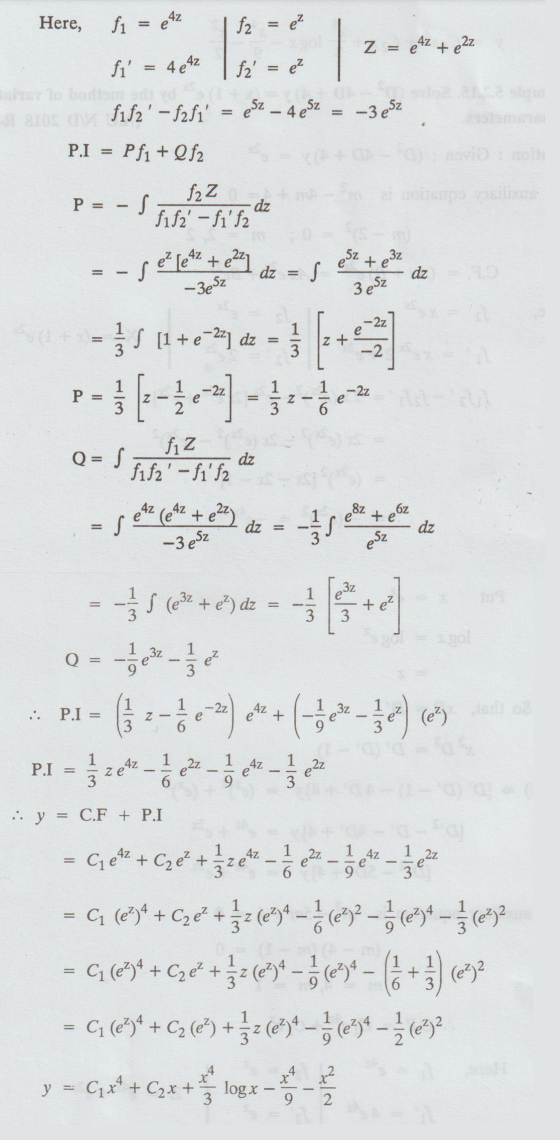
y
= C1x4 + C2x+ x4/3 log x – x4/9 – x2/2+
Example 5.2.15. Solve (D2
- 4D + 4) y = (x + 1) e2x by the method of variation of parameters.
[A.U N/D 2018 R-17]
Solution:
Given: (D2 - 4D + 4) y = e2x
The
auxiliary equation is m2 - 4m + 4 = 0
(m-2)2
= 0; m = 2,2
C.F
= (Ax + B)e2x = Axe2x +
Be2x
Here
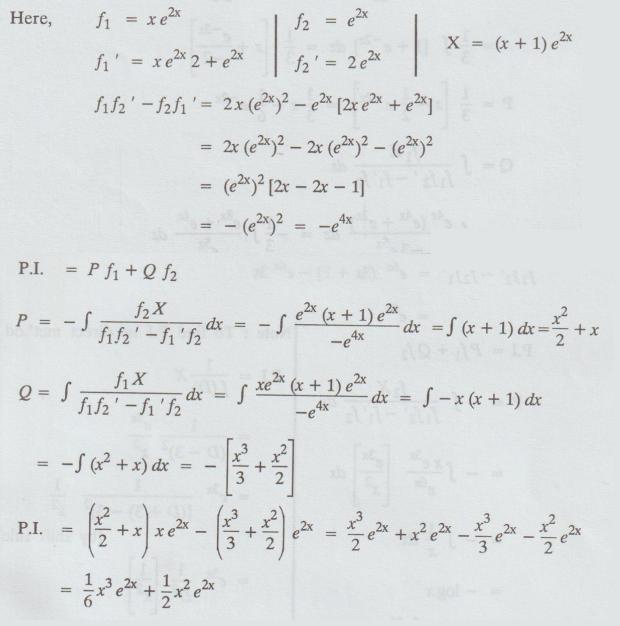
y
= C.F + P.I.
y
= (Ax + B) e2x + 1/6 x3 e2x + ½ x2
e2x
Example 5.2.16 Using the method of
variation of parameters, solve d2y/dx2
– 6 dy/dx + 9y= e3x /x2
Solution:
Given: d2y/dx2 – 6 dy/dx + 9y= e3x /x2
i.e.,
D2y - 6Dy + 9y = e3x/x2
[D2
- 6D + 9] y = e3x /x2
The
auxiliary equation is m2 - 6m +9 = 0
(m − 3)2 = 0; m = 3, 3
C.F
= (C1+ C2x) e3x
Here,

Example 5.2.17. Solve (D2
+ 2D + 5) y = e-x tan x.
Solution:
Given: (D2 + 2D + 5) y = e-x
tan x
The
auxiliary equation is m2 + 2m + 5 = 0
M
= -2 ± √4 – 20 /2 = -1± 12i
C.F=
e-x [C1 cos 2x + C2 sin 2x]
=
C1e-x cos 2x + C2 e-x sin 2x
=
C1f1 + C2f2
Here
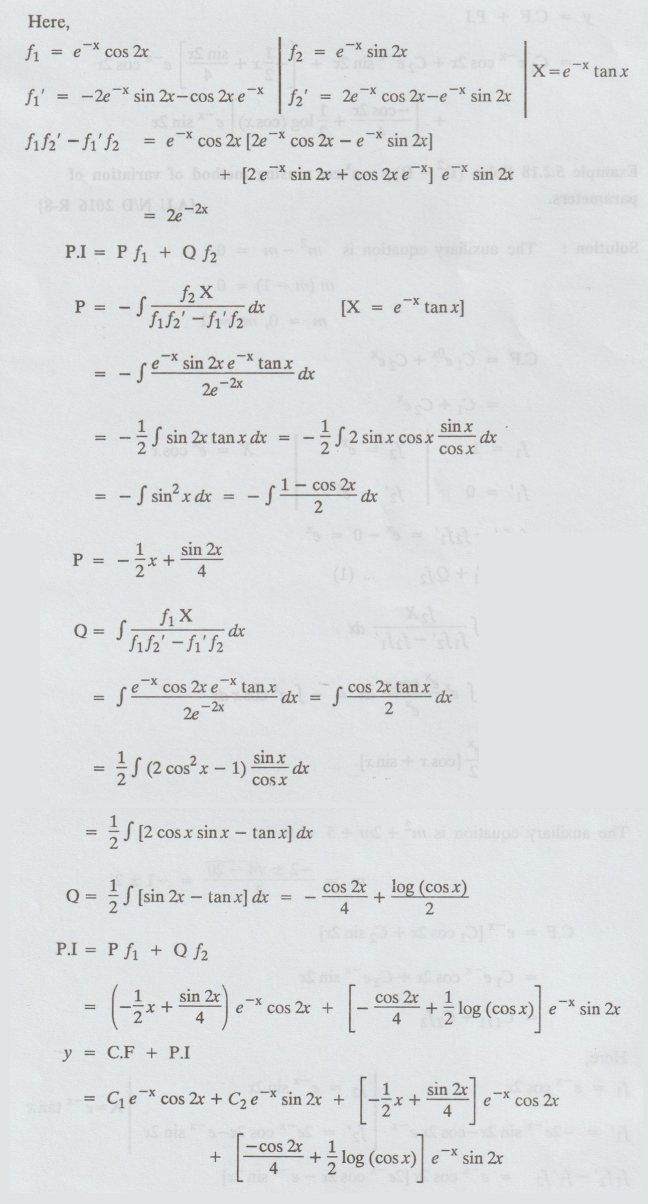
Example 5.2.18 Solve (D2
- D) y = ex cos x using method of variation of parameters. [A.U N/D
2016 R-8]
Solution
: The auxiliary equation is m2 - m = 0
m
(m − 1) = 0
m
= 0, m = 1
C.F
= C1e0x + C2 ex
=
C1 + C2ex
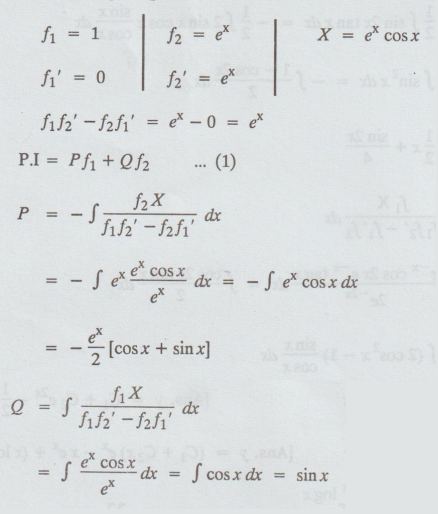
P.I
= -ex/2 [cos x + sin x ] + sin x ex
y
= C.F + P.I
y
= C1 + C2 ex -ex/2 [cos x + sin x ]
+ sin x ex
Probability and complex function: Unit V: Ordinary Differential Equations : Tag: : Solved Example Problems | Ordinary Differential Equations - Problems based on method of variation of parameters
Related Topics
Related Subjects
Probability and complex function
MA3303 3rd Semester EEE Dept | 2021 Regulation | 3rd Semester EEE Dept 2021 Regulation
